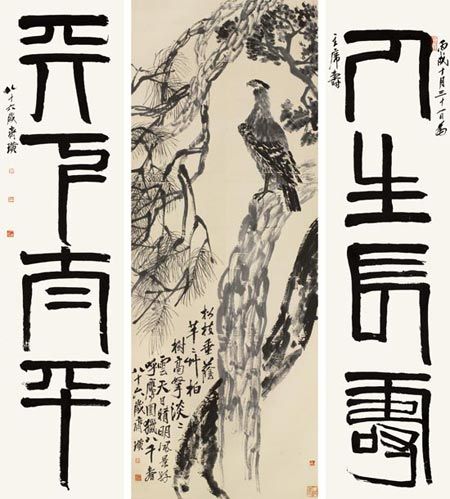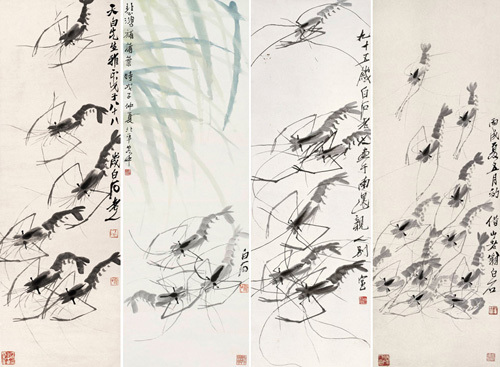
An ink-wash painting by Qi Baishi (1864-1957) is sold for 425.5 million yuan ($65.5 million) during the Guardian Spring Auction at the Beijing International Hotel Convention Center in May 2011.

Qi Baishi is good at shrimps. His shrimps are real in appearance.
(Ecns.cn)--January 1, 2012 will mark the 148th birthday of Qi Baishi, an influential Chinese painter who was mostly known for the whimsical and often playful style of his watercolor works.
As the saying goes, great minds mature slowly. Born in a village in Xiangtan, Hunan Province in 1864, Qi had gained a considerable reputation by the age of 58.
Once a carpenter, Qi was also good at seal carving and poetry. "I am good at poetry first of all, and then carving, calligraphy and painting," he once commented. In total, Qi created over 30,000 paintings, more than 3,000 poems and about 3,000 carvings.
At age 53, Qi was forced to leave his hometown, and eventually settled down in Beijing in 1917. It was there that he met Chen Shizeng, a good judge of talent who took Qi under his wing and sharpened his wits.
Before becoming famous, Qi lived in Fayuan Temple, Beijing's oldest Buddhist temple, where he managed to survive by selling carvings and paintings.
"Busy painting and carving during daytime, I found it hard to fall asleep at night, with all sorts of feelings welling up in my heart," said Qi. "Who could predict that I would have to stay so far from my parents, wife, children, relatives and friends in my declining years?"
His business was very slow at the beginning, and Qi could barely make ends meet. But when he met Chen, who was the brother of a well-known painter and a close friend of literary giant Lu Xun, his fate was completely changed.
Chen, a teacher of traditional Chinese painting at Beijing Normal University, paid Qi a special visit after seeing some seals that he had carved at a market.
"We became sworn friends after several talks," Qi said of the meeting, adding that "it was a memorable event."
Chen greatly appreciated Qi's paintings and pointed out some of the shortcomings. "Be innovative and flexible in your painting skills," he suggested.
Qi accepted the suggestions and decided to bring about drastic reforms by modernizing traditional Chinese painting, a move Qi named the "twilight-year reforms."
In 1992, Chen took some of Qi's paintings to Japan while attending an exhibition. The drawings turned out to be very popular and sold at high prices, which brought Qi considerable fame worldwide.
Qi's business began to pick up as many upper-class art lovers rushed to buy his masterpieces. "This owes much to Chen. I will never forget him," said Qi.
Unfortunately, Chen died a year later at the age of 48, which wrung Qi's heart to the very core.
In the 1920s, people advised Qi to carve out his career in Japan, as his paintings had already gained popularity there and the country is not far from China.
But Qi refused. "I've been in Beijing for nearly nine years and can survive on earnings from my paintings. I have many more customers than before. It's enough for me to have bread and a fireplace when I'm hungry and cold. Why should I have to fight desperately for that much money?"
Qi spent most of his remaining years in Beijing until 1957, when he died at age 93.
Both of Qi's houses in Beijing are located in business districts, with one near Xidan surrounded by skyscrapers, and the other near Nanluoguxiang, a famous tourist destination known for its boutiques, restaurants and bars.

Copyright ©1999-2011 Chinanews.com. All rights reserved.
Reproduction in whole or in part without permission is prohibited.